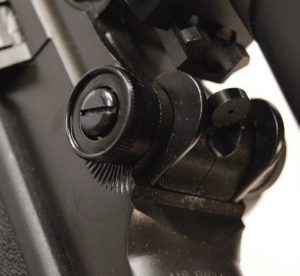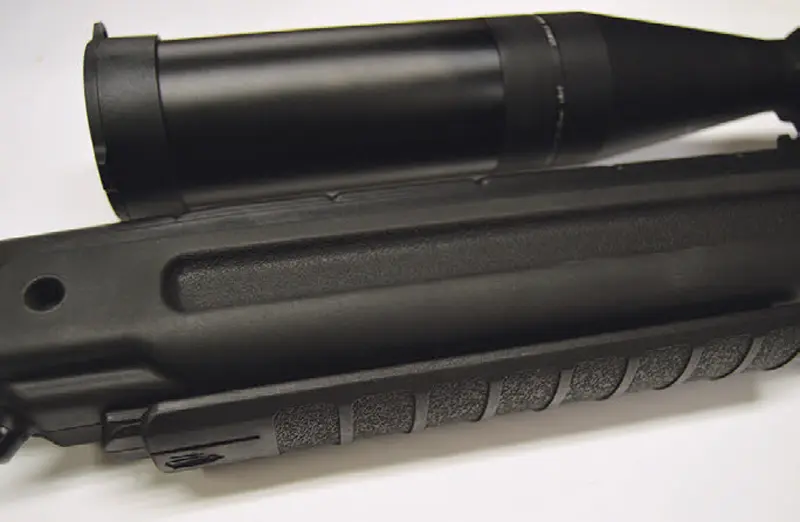

I’VE had a long relationship with the M1A/M14. I first came across the rifle when I was five or six and a friend of my Dad brought a plastic one over as a Christmas present. It was life sized with a small battery pack in the buttstock that was hooked to the trigger and muzzle, which would flash when the trigger was pulled. The rifle would also make a bang sound. It was the coolest thing I’d ever seen.
As a member of the U.S. Army Marksmanship Training Unit (MTU) at Ft. Meade, Maryland, in the 1980s, I had the opportunity to attend the National Match Armorer’s Course at Rock Island Arsenal and was taught how to build the M14 into the National Match rifle and the M21 sniper system.

As part of the course, I built two rifles and they both shot pretty well, printing five-shot groups of about ¾ inch with Lake City ball ammo as shot out of the rifle cradle. Rebarreling, trigger work, glass bedding, and other tricks of the trade opened my eyes as to what the rifle was capable of.
I was also able to attend a couple of sniper schools while I was with MTU #1 and
got a chance to use the M21 with the ART II scope during the day and the PVS-2 night scope during the night firing portion of both courses.
I earned a healthy respect for the capabilities of the rifle over the years, and am still impressed by it and its outstanding qualities that persist today.
With this frame of reference, I received the latest version of this excellent battle rifle from Springfield Armory.

Table of Contents
LOADED M1A
Springfield Armory offers the M1A in several variations in the stock and barrel. The rifle I chose was their Loaded model, with a Black adjustable stock and 22-inch medium weight stainless National Match barrel. The rifle is also available with a Parkerized carbon-steel barrel and composite standard configuration stock in either Black or Tan.
Loaded M1A is an apt moniker, starting with the most striking aspect of the rifle, the stock, which is completely different from a standard M1A stock. The pistol grip is much straighter than the standard stock, making it comfortable to shoot prone off sandbags, bipod, or from the bench. It also has a nice palm swell—a feature I’ve always liked on most any rifle I’ve shot.

The buttplate and cheekpiece are fully adjustable by simply turning a wheel, and those adjustments are positive and repeatable. They are also easy to perform with gloves on. The cheekpiece is a saddle type that is very comfortable from either side of the rifle, and there are a wide range of adjustments, around three inches, which should accommodate virtually any shooter and scope ring height. My son and I shot the rifle at the range and since we are of similar height and reach, we didn’t have to make any adjustments to the stock, but it’s nice to know it’s possible.
The stock comes with a rail section on the forend to allow for attachment of accessories, and also has two sling swivel studs mounted on the buttstock and the tip of the forend. The stock is very sturdy, extremely well made, and should stand up to the use and abuse dished out in a tactical environment. The forend has reinforcing ribs running its length, which will help keep the stock from being squeezed and collapsing. This is very good engineering.

MATCH GRADE BARREL
The barrel on the Loaded M1A is the outstanding medium-weight air-gauged stainless-steel Match Grade barrel. It’s 22 inches long and has a 1:11 right-hand six-groove twist. The rifle also can be purchased with a carbon-steel barrel and Parkerized finish. I always opt for stainless- steel barrels when I can, since stainless barrels normally last longer than a carbon-steel barrel, all things being equal.
I mentioned that the barrels are airgauged. While many people have heard the term, they may not know what it is. Airgauging is a very precise way to measure variations in the internal dimensions of any barrel. I had an air-gauge tool when I was in charge of a DoD small arms R&D facility. I used it to measure our 1911 .45 ACP Match barrels for consistency when I received them from the vendor prior to fitting, to ensure we were getting consistent Match Grade barrels from the manufacturer.

The way it works is, you take a mandrel of known diameter that is mounted on a long rod with the rifling ground into it, and run it through the barrel. The gauge forces air through the rod and the mandrel, which has tiny holes in it, and measures the amount of air resistance or back pressure between the mandrel and the barrel. This resistance is translated into a direct measurement of variations in internal bore diameter to ten-thousandths of an inch, which is displayed on the gauge in digital form. It’s a very efficient, non-contact way to measure internal diameters.
Everything that’s attached to this barrel is National Match, from the gas system to the flash suppressor, front sight and rear sight assembly. The front sight is a .062- inch wide National Match blade type sight, which is mated with a National Match non-hooded rear aperture sight that has a .052-inch opening. The rear sight has ½ MOA adjustments for windage and 1 MOA adjustments for elevation.

The Loaded M1A weighs about 11 pounds empty. A scope, scope mount, and loaded 20-round magazine increase that considerably. The upside to this weight is recoil dampening, and the rifle is really fun and easy to shoot double taps with. Overall length is 46.25 inches with the buttstock extended.
The trigger mechanism is the standard two-stage M1A trigger but is tuned for an excellent 4- to 4.5-pound weight of pull. The pull was consistent from shot to shot and had minimal overtravel and zero creep.
I spent considerable time during my class at Rock Island Arsenal and with the riflesmiths at MTU #1 learning about trigger systems and other accuracy techniques, and the folks at Springfield Armory really get this part right. The triggers are outstanding.

ACCESSORIES
The scope I chose for this rifle was the excellent Leupold Mark 4 LR/T 6.5X20 with Illuminated Mil-Dot reticle. This scope has served me well for many rifle projects and has never disappointed.
The scope mount from Springfield Armory was their side mount that attaches to the side of the receiver and the top stripper clip guide. The scope mount has the standard Picatinny rail system with ample room to mount the scope at the proper position for eye relief. I didn’t have time to test the mounting system for repeatability of the mount, but it looks extremely sturdy, and I have no doubt about its serviceability.

I used the Nightforce TS-82 20X70, one of the finest spotting scopes I’ve ever used, for this test. It weighs 87 ounces and comes with either a 45-degree angled eyepiece or a straight eyepiece. I chose the 45-degree angled eyepiece, but I like both. Nightforce makes an iPhone adapter that lets the iPhone take photos and video through the eyepiece of the scope.
The scope’s excellent field of view and clarity make the targets pop. Controls are easy to use even with gloves on. The scope has accessories such as a full body scope cover, hard carrying case, and more available.
RANGE TESTING
Once I had attached the Leupold scope to the rifle with the Mark 4 rings, it was time to head to the range. I had several types and brands of ammo. One of the newest was a couple of boxes from Applied Ballistics Munitions (ABM), a round that is loaded with the excellent Berger 175-grain bullet and is part of ABM’s tactical ammunition line.

ABM makes loads specifically designed for either Match shooting or tactical use. Since I was using the M1A as a Match Grade tactical rifle, not as a purely competitive Match rifle, the tactical load was appropriate.
The other rounds I tested all have produced excellent results: Black Hills Match loaded with 168-grain boat-tail hollow-point (BTHP), Hornady Match 168-grain BTHP, and the Nosler Match Grade Custom Competition round loaded with 168-grain BTHP.
The ABM round shot the best, but it’s also the most expensive. This is a tactical load, so price theoretically shouldn’t be a consideration because lives are on the line, but with law enforcement budgets being what they are, price is always important.
At my range, we have a swinging eight-inch steel plate positioned at the 300-yard line. White and red steel plates are mounted above, in front and behind the plate. When the plate is hit, it will swing front to back, and the red and white plates are alternately exposed, showing the plate has been hit, which is not always easy to see at 300 yards.
My son and I banged away at the plate all day long with the precision rifle until it was almost boring. We were wishing the plate were out at 500 or 600 yards for more of a challenge, but even at that yardage I don’t think it would have been too difficult with this rifle/ scope/ammo combination once we got the scope dialed in.
All in all, the Springfield Loaded M1A carries on the fine tradition of the original M14/M21 system, with some great upgrades.
The rifle’s stock is a huge improvement, and the Match grade additions like the reworked trigger pull, Match Grade barrel, sights, and gas system with operating rod really combine to make this a self-loading tactical rifle that’s hard to beat.





